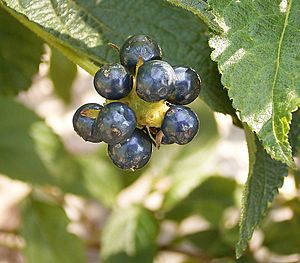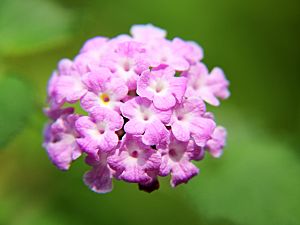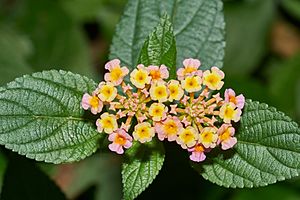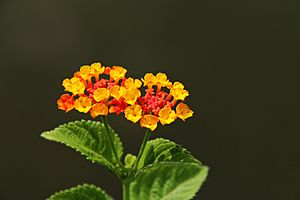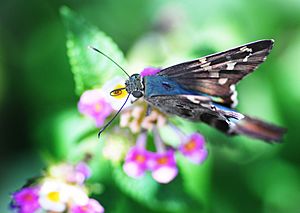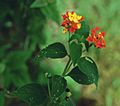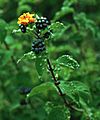Big-sage facts for kids
Quick facts for kids Lantana |
|
|---|---|
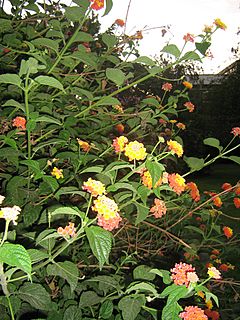 |
|
| Spanish Flag Lantana camara | |
| Scientific classification | |
| Kingdom: | |
| Division: | |
| Class: | |
| Order: | |
| Family: | |
| Genus: |
Lantana
|
Lantana camara, also known as big-sage (Malaysia), wild-sage, red-sage, white-sage (Caribbean) and tickberry (South Africa), is a species of flowering plant within the verbena family, Verbenaceae, that is native to the American tropics.
Lantana camara, often planted to embellish gardens, has spread from its native Central and South America to around 50 different countries, where it has become an invasive species. It spread from the Americas into the rest of the world when it was brought back to Europe by Dutch explorers and cultivated widely, soon spreading into Asia and Oceania, where it established itself as a notorious weed.
Lantana camara will often outcompete other more desirable species, leading to a reduction in biodiversity. It can also cause problems if it invades agricultural areas as a result of its toxicity to livestock as well as its ability to form dense thickets which if left unchecked can greatly reduce the productivity of farm land.
Contents
Description
Lantana camara is a small perennial shrub which can grow to around 2 m tall and form dense thickets in a variety of environments. Due to extensive selective breeding throughout the 17th and 18th Centuries for use as an ornamental plant there are now many different L. camara cultivars.
Lantana camara has small tubular shaped flowers which each have four petals and are arranged in clusters in terminal areas stems. Flowers come in many different colours including red, yellow, white, pink and orange which differ depending on location in inflorescences, age, and maturity. After pollination occurs the colour of the flowers change (typically from yellow to orangish, pinkish, or reddish), this is believed to be a signal to pollinators that the pre-change colour contains a reward as well as being sexually viable, thus increasing pollination efficiency.
The leaves are broadly ovate, opposite, and simple and have a strong odour when crushed.
The fruit of L. camara is a berry-like drupe which turns from green to dark purple when mature. Both vegetative (asexual) and seed reproduction occur. Up to 12,000 fruits can be produced by each plant which are then eaten by birds and other animals which can spread the seeds over large distances, facilitating the spread of L. camara.
The flower has a tutti frutti smell with a pepper undertone.
Distribution
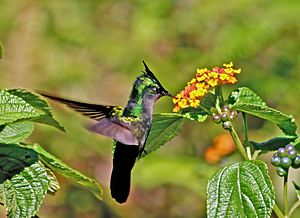
The native range of L. camara is Central and South America, however it has become naturalised in around 60 tropical and sub-tropical countries worldwide. It is found frequently in East and South Africa where it occurs at altitudes below 2000 m and often invades previously disturbed areas such as logged forests and areas cleared for agriculture.
Lantana camara has also colonized areas of Africa, Southern Europe, such as Spain and Portugal, the Middle East, India, tropical Asia, Australia, New Zealand, the USA, as well as many Atlantic, Pacific and Indian Ocean islands. It has also become a significant weed in Sri Lanka after escaping from the Royal Botanic gardens of Sri Lanka in 1926.
It was introduced into the Philippines from Hawaii as part of an exchange program between the United States and the Philippines, however it managed to escape and has become naturalised in the islands.
The range of L. camara is still increasing, shown by the fact that it has invaded many islands on which it was not present in 1974 (including the Galapagos Islands, Saipan and the Solomon Islands). There is also evidence that L. camara is still increasing its range in areas where it has been established for many years, such as East Africa, Australia and New Zealand. The ability of L. camara to rapidly colonise areas of land which have been disturbed has allowed it to proliferate in countries where activities such as logging, clearance for agriculture and forest fires are common. Whereas in countries with large areas of intact primary forest, the distribution of L. camara has been limited.
Ecology
Habitat
Lantana camara is found in a variety of environments, including:
- Agricultural areas
- Forest margins and gaps
- Riparian zones
- Grasslands
- Secondary forest, and
- Beach fronts.
Lantana camara is rarely found in natural or semi-natural areas of forest as it is unable to compete with taller trees due to its lack of tolerance for shade, and instead grows at the forest edge. Lantana camara can survive in a wide range of climatic conditions, including drought, different soil types, heat, humidity and salt. It is also relatively fire tolerant and can quickly establish itself in recently burnt areas of forest.
Invasive species
Lantana camara is considered to be a weed in large areas of the Paleotropics where it has established itself. In agricultural areas or secondary forests it can become the dominant understorey shrub, crowding out other native species and reducing biodiversity. The formation of dense thickets of L. camara can significantly slow down the regeneration of forests by preventing the growth of new trees.
Although L. camara is itself quite resistant to fire, it can change fire patterns in a forest ecosystem by altering the fuel load to cause a buildup of forest fuel which increases the risk of fires spreading to the canopy. This can be particularly destructive in dry, arid areas where fire can spread quickly and lead to the loss of large areas of natural ecosystem.
Lantana camara reduces the productivity in pasture through the formation of dense thickets which reduce growth of crops as well as make harvesting more difficult. There are also secondary impacts, including the finding that mosquitos which transmit malaria and tsetse flies in Africa shelter within the bushes of L. camara.
Even though L. camara is considered invasive to the western ghats the plant does not seem to impact biodiversity in the region, rather it tends to simply occupy the same moist regions as other species.
There are many reasons why L. camara has been so successful as an invasive species; however, the primary factors which have allowed it to establish itself are:
- Wide dispersal range made possible by birds and other animals which eat its drupes
- Less prone to being eaten by animals due to toxicity
- Tolerance of a wide range of environmental conditions
- Increase in logging and habitat modification which has been beneficial to L. camara as it prefers disturbed habitats
- Production of toxic chemicals which inhibit competing plant species
- Extremely high seed production (12,000 seeds from each plant per year)
Toxicity
Lantana camara is known to be toxic to livestock such as cattle, sheep, horses, dogs and goats. The active substances causing toxicity in grazing animals is pentacyclic triterpenoids which result in liver damage and photosensitivy. L. camara also excretes chemicals (allelopathy) which reduce the growth of surrounding plants by inhibiting germination and root elongation.
The toxicity of L. camara to humans is undetermined, with several studies suggesting that ingesting berries can be toxic to humans, such as a study by O P Sharma which states "Green unripe fruits of the plant are toxic to humans". However other studies have found evidence which suggests that ingestion of L. camara fruit poses no risk to humans and are in fact edible when ripe.
Management and control
Effective management of invasive L. camara in the long term will require a reduction in activities which create degraded habitats. Maintaining functioning (healthy) ecosystems is key to preventing invasive species from establishing themselves and outcompeting native fauna and flora.
Biological
Insects and other biocontrol agents have been implemented with varying degrees of success in an attempt to control L. camara. It was the first weed ever subjected to biological control, however none of the programs have been successful despite 36 control agents being used across 33 regions.
The lack of success using biological control in this case is most likely due to the many hybrid forms of L. camara as well as the large genetic diversity which make it difficult for the control agents to effectively target all plants. A recent study in India has thrown some results around biological control of this using tipid bugs.
Mechanical
Mechanical control of L. camara involves physically removing the plants. Physical removal can be effective but is labour-intensive and expensive, therefore removal is usually only appropriate in small areas. Another method of mechanical control is to use fire treatment followed by revegetation with native species.
Chemical
Using herbicides to manage L. camara is very effective but also expensive (prohibiting its use in many poorer countries where L. camara is well established). The most effective way of chemically treating plant species is to first mow the area then spray the area with a herbicide (weed-killer), although this may have serious environmental consequences.
Uses
Lantana camara stalks have been used in the construction of furniture, such as chairs and tables; however, the main uses have historically been medicinal and ornamental.
Medicinal value
Studies conducted in India have found that Lantana leaves can display antimicrobial, fungicidal and insecticidal properties. L. camara has also been used in traditional herbal medicines for treating a variety of ailments, including cancer, skin itches, leprosy, rabies, chicken pox, measles, asthma and ulcers.
There are also some scientific studies which have shown beneficial effects of L .camara, such as one by R. Satish which found that an extract from the plant reduced ulcer development in rats. Extracts from the plant have also been used to treat respiratory infections in Brazil.
Ornamental
Lantana camara has been grown specifically for use as an ornamental plant since Dutch explorers first brought it to Europe from the New World. Its ability to last for a relatively long time without water and that it does not have many pests or diseases which affect it have contributed to it becoming a common ornamental plant. Lantana camara also attracts butterflies and birds and so is frequently used in Florida's butterfly gardens.
As a host-plant
Many butterfly species feed on the nectar of L. camara. Papilio homerus, the largest butterfly in the western hemisphere, is known to feed on the nectar of the flowers as opportunistic flower feeders.
Etymology
The name Lantana derives from the Latin name of the wayfaring tree Viburnum lantana, the flowers of which closely resemble Lantana.
Camara is derived from Greek, meaning ‘arched’, ‘chambered’, or ‘vaulted’.
Gallery
Images for kids
-
4.5 m (15 ft) tall shrubs infesting a native woodland area in Sydney
See also
 In Spanish: Lantana para niños
In Spanish: Lantana para niños


